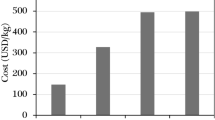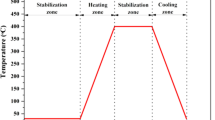Abstract
Class-F fly ash (FA) from a coal-fired thermal power station was subjected to high energy ball milling-induced mechanochemical activation aided by a surfactant. Subsequently, ethylene-octene copolymer/mechanochemically activated FA (EOC/MCA-FA) composites were prepared by solution casting. The surface modification of FA was confirmed from contact angle measurements and FTIR spectroscopy, which accounts for a good interaction between MCA-FA and the polymer matrix. X-ray diffraction reveals that the crystallite size of quartz phase present in FA got reduced, while the relative lattice strain on it increased during milling. Morphological studies revealed that interfacial adhesion between the polymer and MCA-FA is good and this accounts for the improvement in mechanical properties of the composites even at the minimum filler loading. Flame retardance of the matrix polymer is improved by the addition of either fresh FA or MCA-FA. The results imply that FA is a valuable reinforcing filler for ethylene-octene copolymer and its mechanochemical activation is an effective strategy for its future use.
Similar content being viewed by others
References
Senapati MR (2011) Fly ash from thermal power plants–waste management and overview. Curr Sci 100(12):1791–1794
Ahmaruzzaman M (2010) A review on the utilization of fly ash. Prog Energy Combust Sci 36(3):327–363
Bandyopadhyay S, Zaeni A, Nath D, Yu A, Zeng Q, Blackburn D, White C (2010) Advanced utilization of as received and near whitened fly ash in polypropylene polymer to improve mechanical, notched impact and whiteness color properties. Int J Plast Technol 14(1):51–56
Iyer R, Scott J (2001) Power station fly ash—a review of value-added utilization outside of the construction industry. Resour Conserv Recycl 31(3):217–228
Paul KT, Satpathy SK, Manna I, Chakraborty KK, Nando GB (2007) Preparation and characterization of nano structured materials from fly ash: a waste from thermal power stations, by high energy ball milling. Nanoscale Res Lett 2(8):397–404
Potgieter-Vermaak SS, Potgieter JH, Kruger RA, Spolnik Z, van Grieken R (2005) A characterisation of the surface properties of an ultra fine fly ash (UFFA) used in the polymer industry. Fuel 84(18):2295–2300
Parvaiz MR, Mohanty S, Nayak SK, Mahanwar PA (2011) Effect of surface modification of fly ash on the mechanical, thermal, electrical and morphological properties of polyetheretherketone composites. Mater Sci Eng A 528(13–14):4277–4286
Sengupta S, Pal K, Ray D, Mukhopadhyay A (2011) Furfuryl palmitate coated fly ash used as filler in recycled polypropylene matrix composites. Compos B Eng 42(7):1834–1839
Satapathy BK, Das A, Patnaik A (2011) Ductile-to-brittle transition in cenosphere-filled polypropylene composites. J Mater Sci 46(4):1963–1974
Kulkarni SM (2002) Effects of surface treatments and size of fly ash particles on the compressive properties of epoxy based particulate composites. J Mater Sci 37(20):4321–4326
Nath DCD, Bandyopadhyay S, Boughton P, Yu A, Blackburn D, White C (2010) Chemically modified fly ash for fabricating super-strong biodegradable poly(vinyl alcohol) composite films. J Mater Sci 45(10):2625–2632
Deepthi MV, Sharma M, Sailaja RRN, Anantha P, Sampathkumaran P, Seetharamu S (2010) Mechanical and thermal characteristics of high density polyethylene–fly ash Cenospheres composites. Mater Des 31(4):2051–2060
Anandhan S, Sundar SM, Senthil T, Mahendran AR, Shibulal GS (2012) Extruded poly(ethylene-co-octene)/fly ash composites – value added products from an environmental pollutant. J Polym Res 19(3):1–11
Baláž P (2008) High-energy milling, in mechanochemistry in nanoscience and minerals engineering, chap 2. Springer-Verlag, Berlin, pp 103–132
Zhang FL, Zhu M, Wang CY (2008) Parameters optimization in the planetary ball milling of nanostructured tungsten carbide/cobalt powder. Refract Met Hard Mater 26(4):329–333
Patil AG, Anandhan S (2012) Ball milling of class-F indian fly ash obtained from a thermal power station. Int J Energy Eng 2(2):57–62
Paul KT, Pabi SK, Chakraborty KK, Nando GB (2009) Nanostructured fly ash–styrene butadiene rubber hybrid nanocomposites. Polym Compos 30(11):1647–1656
Satapathy S, Nag A, Nando GB (2012) Effect of electron beam irradiation on the mechanical, thermal, and dynamic mechanical properties of fly ash and nanostructured fly ash waste polyethylene hybrid composites. Polym Compos. doi: 10.1002/pc.22140
Satapathy S, Nando GB, Nag A, Raju KVSN (2013) HDPE-fly ash/nano fly ash composites. J App Polym Sci. doi: 10.1002/app.39733
Ma X, Lu H, Liang G, Yan H (2004) Rectorite/thermoplastic polyurethane nanocomposites: preparation, characterization, and properties. J Appl Polym Sci 93:608–614
ASTM D 854-10Standard test methods for Specific gravity of soil solids by water pycnometer. ASTM International; March 2010
ASTM D 638-10Standard test method for tensile properties of plastics. ASTM International; June 2010
ASTM D 412-06aStandard test methods for vulcanized rubber and thermoplastic elastomers—tension. ASTM International; April 2013
ASTM D 2863Standard test method for measuring the minimum oxygen concentration to support candle-like combustion of plastics (Oxygen Index). May 2012
Ashby M F, Ferreira P J, Schodek D L (2009) Nanomaterials, nanotechnologies and designs. Elsevier, Oxford
Nath DCD, Bandyopadhyay S, Gupta S, Yu A, Blackburn D, White C (2010) Surface-coated fly ash used as filler in biodegradable poly(vinyl alcohol) composite films: Part 1—The modification process. Appl Surf Sci 256(9):2759–2763
Nath DCD, Bandyopadhyay S, Yu A, Blackburn D, White C (2010) High strength bio-composite films of poly(vinyl alcohol) reinforced with chemically modified-fly ash. J Mater Sci 45(5):1354–1360
http://www.surface-tension.de/. Accessed 10 Aug 2013
Nalbantoğlu Z (2004) Effectiveness of Class C fly ash as an expansive soil stabilizer. Construct Build Mater 18(4):377–381
Mishra SR, Kumar S, Wagh A, Rho J Y, Gheyi T (2003) Temperature-dependent surface topography analysis of Illinois class F fly ash using ESEM and AFM. Mater Lett 57(16–17):2417–2424
Thongsang S, Sombatsompop N (2006) Effect of NaOH and Si69 treatments on the properties of fly ash/natural rubber composites. Polym Compos 27(1):30–40
Cullity BD, Stock SR (2001) Elements of X-ray diffraction, 3rd edn. Prentice-Hall, New Jersey
Yang Q, Zhao L, Xiao H, Zhao N (2000) Analysis of intrinsic stress in diamond films by X-ray diffraction. International centre for diffraction data. Adv X-ray Analy 43:151–156
Khan MJ, Al-Juhani AA, Shawabkeh R, Ul-Hamid A, Hussein IA (2011) Chemical modification of waste oil fly ash for improved mechanical and thermal properties of low density polyethylene composites. J Polym Res 18(4):2275–2284
Swami PN, Raju BN, Rao DV, Rao JB (2009) Synthesis and characterization of nano-structured fly ash: a waste from thermal power plant. Proceedings of the institution of mechanical engineers. Part N: J Nanoengineer and Nanosys 223(2):35–44
Nath DCD, Bandyopadhyay S, Yu A, Zeng Q, Das T, Blackburn D, White C (2009) Structure–property interface correlation of fly ash–isotactic polypropylene composites. J Mater Sci 44(22):6078–6089
Friel JJ, Grande JC, Hetzner D, Kurzydlowski K, Laferty D, Shehata MT, Smolej V, Voort GFV, Wojnar LA (2000) Practical guide to image analysis, ASM International, Materials Park, Ohio, USA
Viana RB, da Silva ABF, Pimentel AS (2012) Infrared spectroscopy of anionic, cationic, and zwitterionic surfactants. Adv Phy Chem. doi: 10.1155/2012/903272
Latta G, Lineberry Q, Ozao R, Zhao H-Y, Pan W-P (2008) Thermal properties of ethylene octene copolymer (Engage)/dimethyldioctadecyl quaternary ammonium chloride-modified montmorillonite clay nanocomposites. J Mater Sci 43(8):2555–2561
Smith B (1999) Infrared spectral Interpretation. Library of congress-in-publication data
Guhanathan S, Devi MS, Murugesan V (2001) Effect of coupling agents on the mechanical properties of fly ash/polyester particulate composites. J Appl Polym Sci 82(7):1755–1760
Nielsen LE (1966) Simple theory of stress-strain properties of filled polymers. J App Polym Sci 10(1):97–103
Nelson MI (2001) A dynamical systems model of the limiting oxygen index test: II. Retardancy due to char formation and addition of inert fillers. Combust Theor Model 5(1):59–83
Búcsi A, Rychlý J (1992) A theoretical approach to understanding the connection between ignitability and flammability parameters of organic polymers. Polym Degrad and Stab 38(1):33–40
Shi XM, Zhang J, Jin J, Chen SJ (2008) Non-isothermal crystallization and melting of ethylene-vinyl acetate copolymers with different vinyl acetate contents, eXPRESS. Polym Lett 2:623–629
Liu M, Guo B, Du M, Chen F, Jia D (2009) Halloysite nanotubes as a novel β-nucleating agent for isotactic polypropylene. Polymer 50(13):3022–3030
Shangguan Y, Song Y, Peng M, Li B, Zheng Q (2005) Formation of β-crystal from nonisothermal crystallization of compression-molded isotactic polypropylene melt. Eur Polym J 41(8):1766–1771
Author information
Authors and Affiliations
Corresponding author
Additional information
The authors would like to dedicate this paper to Mrs. G. M. Patil, the mother of Akshata G. Patil, who unexpectedly left this world on the 22nd of October 2013.
Rights and permissions
About this article
Cite this article
Patil, A.G., Mahendran, A. & Anandhan, S. Nanostructured Fly Ash as Reinforcement in a Plastomer-Based Composite: A New Strategy in Value Addition to Thermal Power Station Fly Ash. Silicon 8, 159–173 (2016). https://doi.org/10.1007/s12633-014-9194-2
Received:
Accepted:
Published:
Issue Date:
DOI: https://doi.org/10.1007/s12633-014-9194-2




